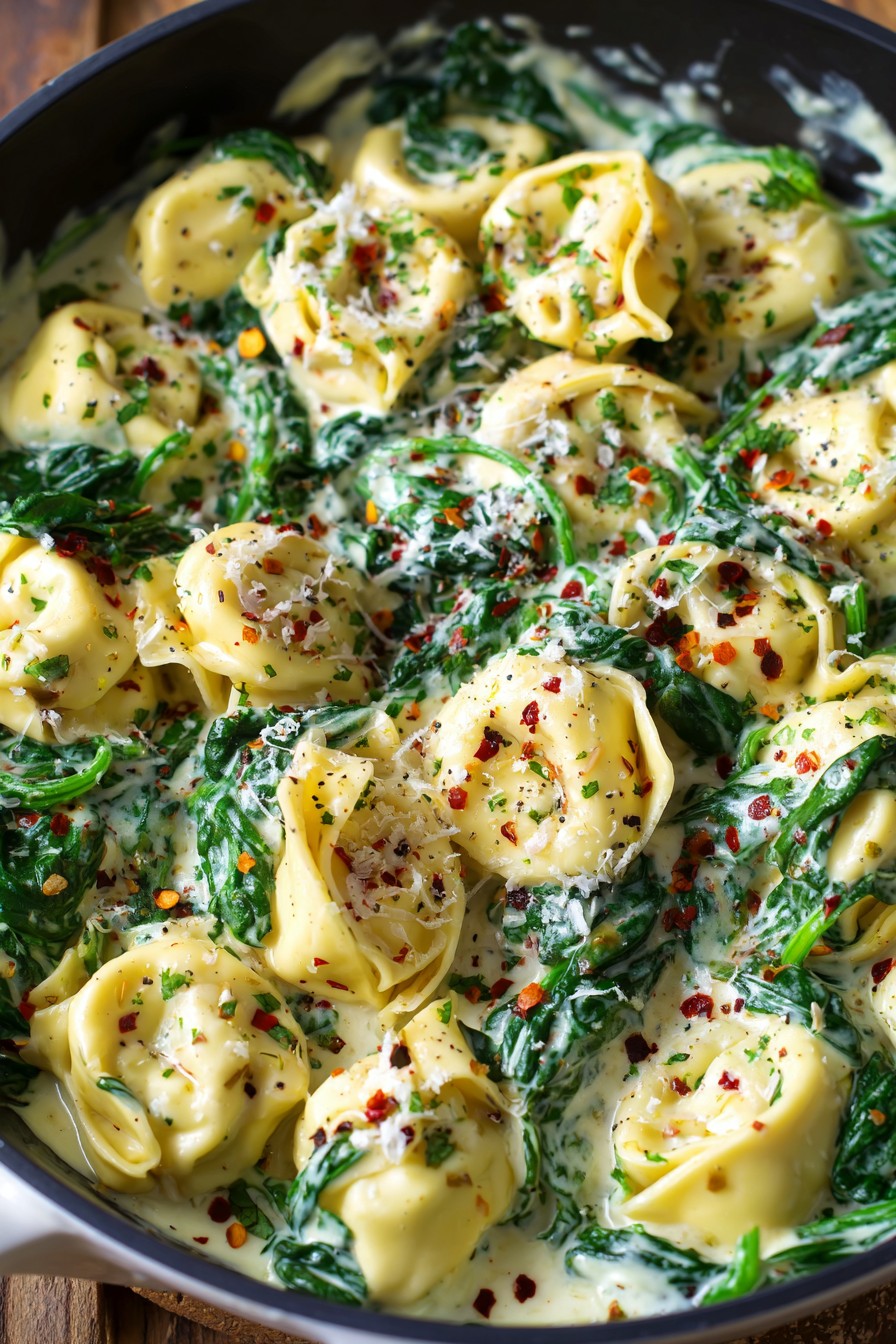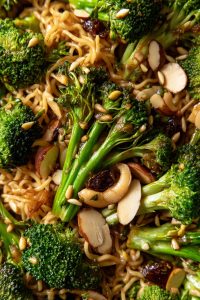Unlocking the full potential of simple ingredients transforms this spinach tortellini into a culinary masterpiece that nourishes both body and soul. Using fresh cheese tortellini as our foundation, we’ll build layers of flavor with garlic, spinach, and a light cream sauce that delivers exceptional taste without excessive calories. This approach demonstrates how strategic ingredient selection and proper cooking techniques can elevate basic components into a restaurant-quality meal you’ll feel good about serving your family.
Why This Recipe Works
- The combination of cheese-filled tortellini and fresh spinach creates a perfect balance of protein, complex carbohydrates, and essential vitamins, making this dish both satisfying and nutritionally complete. Spinach provides iron, vitamin K, and antioxidants that support bone health and reduce inflammation, while the cheese filling offers calcium and protein for sustained energy.
- Using both fresh garlic and garlic powder provides layered flavor complexity – the fresh garlic delivers immediate aromatic impact while the powder integrates seamlessly into the sauce base. This dual approach ensures every bite carries the distinctive garlic essence without overwhelming the delicate cheese tortellini filling.
- The light cream sauce achieves richness through strategic reduction rather than excessive fat content, allowing the natural flavors to shine while maintaining a health-conscious profile. By slowly simmering the cream with seasonings, we develop depth and body that coats each tortellini perfectly without feeling heavy or overly indulgent.
- Quick cooking techniques preserve the nutritional integrity of the spinach while maintaining ideal texture in the tortellini, ensuring maximum nutrient retention and perfect al dente pasta. The brief wilting process for spinach maintains its vibrant color and delicate structure while keeping valuable water-soluble vitamins intact.
- Strategic seasoning with nutritional yeast adds umami depth and B-vitamins while reducing the need for excessive salt, creating a flavor profile that satisfies both health goals and culinary expectations. This clever substitution enhances the cheesy notes while providing additional protein and essential nutrients often lacking in traditional pasta dishes.
Ingredients
- 1 pound fresh cheese tortellini
- 4 cups fresh spinach leaves, thoroughly washed
- 3 cloves garlic, minced
- 1 cup heavy cream
- 1/2 cup grated Parmesan cheese
- 2 tablespoons olive oil
- 1 teaspoon garlic powder
- 1/2 teaspoon black pepper
- 1/4 teaspoon salt
- 2 tablespoons nutritional yeast
- 1/4 teaspoon red pepper flakes
- 1 tablespoon fresh lemon juice
Equipment Needed
- Large stockpot
- Colander
- Large skillet
- Wooden spoon
- Measuring cups and spoons
- Cheese grater
- Cutting board
- Chef’s knife
Instructions

Prepare the Tortellini Base
Begin by bringing 4 quarts of water to a rolling boil in your large stockpot, adding 1 tablespoon of salt to the water once it reaches boiling point. This salted water not only seasons the tortellini from within but also helps maintain the pasta’s structural integrity during cooking. Carefully add the fresh cheese tortellini to the vigorously boiling water, stirring gently for the first minute to prevent sticking. Cook for exactly 3-4 minutes or until the tortellini float to the surface and appear slightly puffed – this visual cue indicates the pasta is perfectly cooked while maintaining that essential al dente texture. Reserve 1/2 cup of the starchy pasta water before draining, as this liquid gold will help emulsify our sauce later. Pro tip: Always taste one tortellini to confirm doneness rather than relying solely on package directions, as altitude and pot size can affect cooking times.
Create the Flavor Foundation
While the tortellini cooks, heat 2 tablespoons of olive oil in your large skillet over medium heat until it shimmers but doesn’t smoke, about 2-3 minutes. Add the minced garlic and cook for precisely 45-60 seconds, stirring constantly until fragrant but not browned – this careful timing preserves the garlic’s delicate flavor compounds while eliminating raw harshness. The moment you detect that distinctive nutty aroma, immediately add the fresh spinach leaves in batches, wilting each addition before adding more. This sequential approach ensures even cooking and prevents the skillet from cooling down too much. Continue stirring until the spinach has reduced in volume by approximately 75% and appears bright green and tender, which typically takes 3-4 minutes total. Pro tip: For maximum nutrient retention, avoid overcooking the spinach – stop when it’s just wilted to preserve water-soluble vitamins like folate and vitamin C.
Develop the Cream Sauce
Reduce the heat to medium-low and pour in 1 cup of heavy cream, stirring constantly to incorporate any browned bits from the skillet bottom. Add the garlic powder, black pepper, and red pepper flakes at this stage, allowing the spices to bloom in the warm cream for 30-45 seconds until the mixture becomes fragrant. Gradually sprinkle in the nutritional yeast while continuously stirring to prevent clumping – this ingredient not only adds cheesy flavor but also provides complete protein and B vitamins. Continue cooking the sauce for 5-7 minutes, stirring frequently until it thickens enough to coat the back of a spoon. You’ll know it’s ready when you can draw a line through the sauce on the spoon and it holds its shape. Pro tip: For a lighter sauce alternative, substitute half the heavy cream with whole milk or unsweetened almond milk, though the thickening time may increase slightly.
Combine and Emulsify
Add the drained tortellini directly to the skillet with your cream sauce, along with 1/4 cup of the reserved pasta water. Increase the heat to medium and toss continuously for 2-3 minutes until the tortellini are evenly coated and the sauce has tightened around the pasta. The starchy pasta water works magic here – its amylose and amylopectin molecules help bind the fat and water elements into a smooth, cohesive sauce that clings perfectly to each tortellini. Sprinkle in the grated Parmesan cheese while tossing, allowing it to melt gradually into the sauce rather than clumping. Continue cooking until the sauce reaches your desired consistency, adding more reserved pasta water if needed. The final sauce should lightly coat each tortellini without pooling in the skillet bottom.
Finish and Season
Remove the skillet from heat and drizzle 1 tablespoon of fresh lemon juice over the completed dish, tossing gently to distribute evenly. The acid from the lemon juice brightens the rich cream sauce and enhances the other flavors while providing vitamin C. Taste carefully and adjust seasoning with additional salt if needed, remembering that the Parmesan and pasta water already contribute sodium. Let the tortellini rest for 2 minutes off heat before serving – this brief resting period allows the sauce to fully penetrate the pasta and the flavors to harmonize. The final dish should present vibrant green spinach leaves nestled among creamy tortellini with a sauce that’s rich but not heavy. Serve immediately while hot for optimal texture and flavor experience.
Tips and Tricks
Mastering the art of perfect spinach tortellini requires attention to several advanced techniques that elevate this dish from good to exceptional. When selecting your tortellini, opt for fresh refrigerated varieties rather than frozen or shelf-stable options, as they typically have superior texture and more delicate pasta wrappers. The filling should contain real cheese rather than processed cheese products for optimal melting characteristics and flavor development. For the spinach, always choose vibrant, crisp leaves without yellowing or wilting – the younger the leaves, the more tender they’ll be when cooked. If you must substitute frozen spinach, be sure to thaw it completely and squeeze out every bit of excess moisture using a clean kitchen towel or cheesecloth, as retained water will dilute your sauce significantly. Regarding the cream sauce, temperature control proves crucial – never allow the cream to boil vigorously, as this can cause separation and a grainy texture. Instead, maintain a gentle simmer where occasional bubbles break the surface. For those monitoring dairy intake, consider using half heavy cream and half whole milk, or explore plant-based alternatives like cashew cream or coconut milk, though these will impart different flavor profiles. The reserved pasta water represents your secret weapon for sauce consistency – its starch content acts as a natural emulsifier and thickener. Always reserve more than you think you’ll need, as you can add it gradually until achieving perfect sauciness. When combining elements, work quickly once the tortellini are drained to prevent them from sticking together – have your sauce ready before the pasta finishes cooking. For garlic enthusiasts, consider adding one additional minced clove during the final minute of cooking for a more pronounced garlic presence. Storage considerations matter too – any leftovers should be cooled completely before refrigerating in an airtight container for up to 3 days. Reheat gently over low heat with a splash of milk or cream to restore sauciness, as the pasta will absorb liquid during storage. Finally, for presentation, garnish with additional freshly grated Parmesan, a sprinkle of red pepper flakes, and perhaps some fresh basil leaves for color contrast and aromatic complexity.
Recipe Variations
- Protein-Packed Version: Transform this vegetarian dish into a heartier meal by adding 8 ounces of cooked, diced chicken breast or 1 cup of canned chickpeas during the sauce development stage. The chicken should be seasoned with salt and pepper before pan-searing until golden brown and cooked through, then rested before dicing. Chickpeas should be rinsed thoroughly and patted dry before adding to the skillet along with the garlic. Both options significantly increase the protein content while maintaining the dish’s nutritional balance. For plant-based protein, consider marinated tofu cubes or tempeh crumbles as alternatives that absorb the sauce beautifully.
- Creamy Tomato Twist: Create a rosé sauce by adding 1/2 cup of tomato puree or crushed San Marzano tomatoes along with the heavy cream. This variation introduces lycopene-rich tomatoes that provide antioxidant benefits while cutting through the richness of the cream. The acidity from tomatoes balances the dish beautifully and creates a vibrant orange-pink sauce that’s visually appealing. Consider adding a pinch of dried oregano or basil to complement the tomato notes. This version works particularly well with mushroom-filled tortellini if you want to explore different pasta fillings.
- Lemon Herb Refresh: Brighten the flavor profile by doubling the lemon juice to 2 tablespoons and adding 1/4 cup of chopped fresh herbs like parsley, basil, or chives during the final tossing stage. The increased acidity provides a refreshing contrast to the rich cheese filling while the fresh herbs contribute additional phytonutrients and vibrant color. This variation feels lighter and works beautifully for spring or summer meals. Consider using a mix of herbs for complexity – try 2 tablespoons parsley with 1 tablespoon each of basil and chives for a balanced herbal bouquet.
- Mushroom Medley Upgrade: Sauté 8 ounces of sliced cremini or shiitake mushrooms along with the garlic until golden brown and their liquid has evaporated, then proceed with the recipe as written. Mushrooms add umami depth and meaty texture while providing B vitamins, selenium, and antioxidants. Their earthy flavor complements the cheese tortellini beautifully and creates a more substantial dish. For maximum flavor, don’t crowd the mushrooms in the pan and allow them to develop a golden crust before stirring.
- Dairy-Free Adaptation: Replace the heavy cream with 1 cup of raw cashews blended with 3/4 cup water until completely smooth, and substitute the Parmesan with 1/4 cup nutritional yeast plus 2 tablespoons of miso paste for cheesy flavor. This vegan version maintains creaminess while offering different nutritional benefits including heart-healthy fats from cashews and probiotics from miso. The sauce will be slightly less thick than the dairy version, so you may need to reduce it longer or add a teaspoon of arrowroot powder dissolved in water to achieve desired consistency.
Frequently Asked Questions
Can I use frozen tortellini instead of fresh?
Yes, frozen tortellini works well in this recipe, though cooking times will differ significantly. Frozen tortellini typically requires 5-7 minutes of boiling rather than the 3-4 minutes for fresh varieties. The key indicator remains the same – the tortellini will float to the surface when properly cooked. However, frozen pasta often contains more water, which can slightly dilute your sauce, so you may need to reduce the sauce for an additional 1-2 minutes to achieve proper consistency. Texture differences are minimal, though some connoisseurs note that fresh tortellini has a slightly more delicate pasta wrapper. From a nutritional perspective, frozen and fresh tortellini have similar profiles, though check labels for sodium content variations between brands.
How can I make this dish ahead of time for meal prep?
This spinach tortellini stores remarkably well for meal preparation, though I recommend keeping components separate until ready to serve for optimal texture. Cook the tortellini and toss with a teaspoon of olive oil to prevent sticking, then store in an airtight container. Prepare the sauce separately and refrigerate in another container. The spinach can be pre-wilted but may darken slightly upon storage. When ready to eat, gently reheat the sauce in a skillet, adding a splash of milk or cream to restore consistency, then add the tortellini and spinach, warming through. Properly stored, components keep for 3-4 days refrigerated. For freezing, I recommend freezing the sauce alone rather than the completed dish, as the tortellini texture can become mushy upon thawing.
What are the best cheese tortellini fillings for this recipe?
For this particular preparation, three-cheese blends or ricotta-based fillings work exceptionally well as they melt beautifully into the cream sauce. Look for tortellini containing Parmesan, Romano, and mozzarella combinations, or simple ricotta with parsley. Avoid strongly flavored fillings like blue cheese or gorgonzola, as they can overwhelm the delicate balance of garlic and spinach. Whole milk ricotta fillings provide creamier texture and richer mouthfeel compared to part-skim varieties. Nutritionally, cheese-filled tortellini typically provides 7-10 grams of protein per serving, along with calcium and vitamin A. For those monitoring sodium, seek out lower-sodium varieties or consider making homemade tortellini with controlled ingredient quality.
Can I substitute another green for the spinach?
Absolutely, several greens work beautifully in this recipe while offering different nutritional profiles. Kale requires longer cooking – add it with the garlic and cook for 5-7 minutes until tender. Swiss chard works similarly to spinach but may need the stems removed and chopped separately, adding them earlier than the leaves. Arugula provides peppery notes and wilts very quickly – add it during the final minute of cooking. For maximum nutrient diversity, consider using a mix of greens – spinach for iron, kale for vitamin K, and arugula for phytochemicals. All these greens provide valuable fiber, vitamins, and minerals while contributing minimal calories, making them excellent additions to this already nutrient-dense dish.
Is this recipe suitable for people with dietary restrictions?
With modifications, this recipe can accommodate several dietary needs. For gluten-free diets, use certified gluten-free tortellini now available in most supermarkets. Dairy-free adaptations work well using plant-based cream alternatives and nutritional yeast instead of Parmesan. For lower-carb approaches, consider using fewer tortellini and increasing the spinach proportion, or explore low-carb tortellini options made with alternative flours. The dish naturally contains no nuts or soy unless added through variations, making it suitable for those allergies. For low-sodium needs, reduce or eliminate added salt and use low-sodium cheese fillings. Always check individual ingredient labels to confirm they meet your specific dietary requirements.
Summary
This spinach tortellini recipe demonstrates how simple ingredients, when prepared with care and knowledge, create a meal that satisfies both nutritional goals and culinary expectations. The combination of cheese-filled pasta, vibrant greens, and carefully balanced cream sauce delivers restaurant-quality results with health-conscious integrity. Perfect for busy weeknights yet impressive enough for company, this dish proves that eating well never requires sacrificing flavor or satisfaction.



